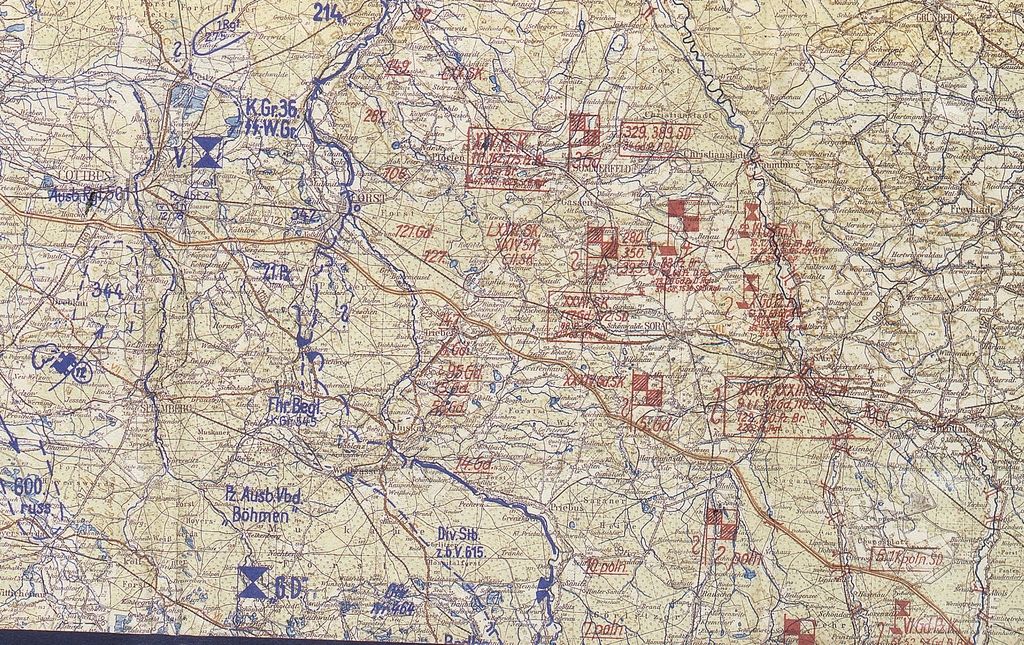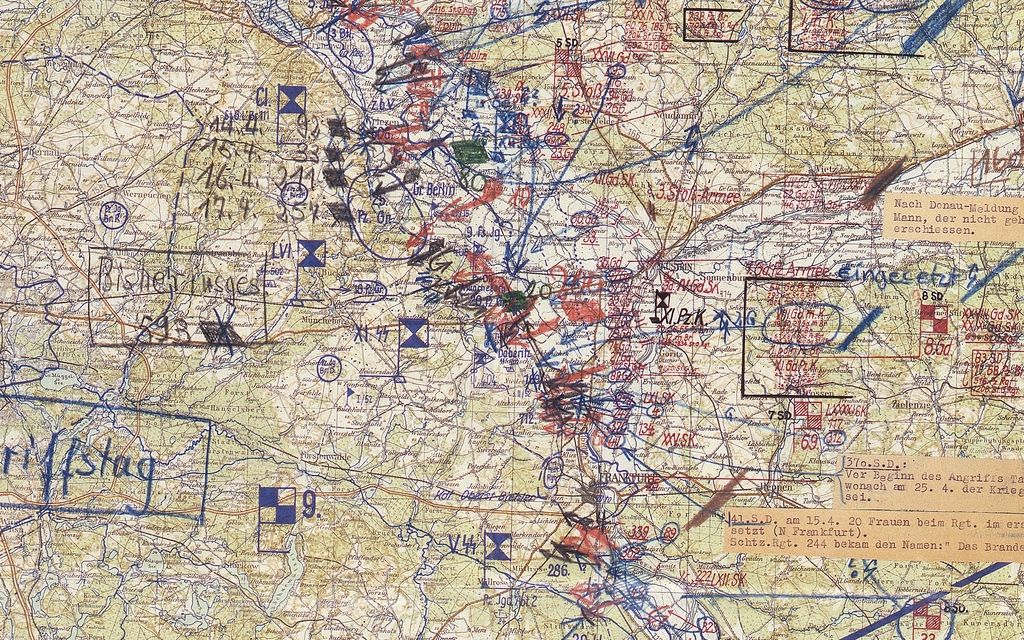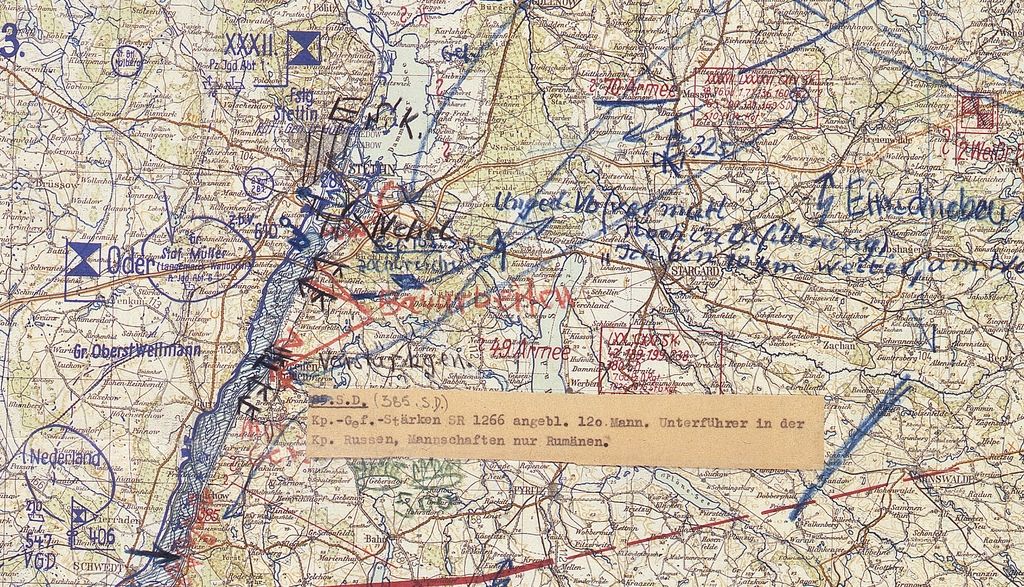The Final Battle has begun. In the south, the Germans have finally identified most of Konev's 1st Ukrainian Front. While the Germans show the Soviet divisions still along the Niesse River, there is a question mark between Führer Begleit Brigade and 21st Panzer Division and the river. Yesterday, there were two skeleton infantry divisions there.

Along the 9th Army Front, the Germans are holding their main defensive line along the Seelöwe Heights west of the Oder. This is the last time a German defensive system will hold back a major Soviet assault for any period of time.

In the north, the Germans helplessly watch the Soviets finish their preparations. The only thing holding them back is the flooded Oder, which will recede in a few days.

The next map will not be available until this Sunday, April 19.
http://en.wikipedia.org/wiki/Battle_of_the_Seelow_Heights
The Battle of the Seelow Heights (German: Schlacht um die Seelower Höhen) was part of the Seelow-Berlin Offensive Operation (16 April-2 May 1945), one of the last assaults on large entrenched defensive positions of World War II. It was fought over three days, from 16–19 April 1945. Close to one million Soviet soldiers of the 1st Belorussian Front (including 78,556 soldiers of the Polish 1st Army), commanded by Marshal Georgi Zhukov, attacked the position known as the “Gates of Berlin”. They were opposed by about 110,000 soldiers of the German 9th Army,[4] commanded by General Theodor Busse, as part of the Army Group Vistula.
This battle is often incorporated into the Battle of the Oder-Neisse. Seelow Heights was where the most bitter fighting in the overall battle took place, but it was only one of several crossing points along the Oder and Neisse rivers where the Soviets attacked. The Battle of the Oder-Neisse was itself only the opening phase of the Battle of Berlin.
The result was the encirclement of the German 9th Army and the Battle of Halbe.
http://www.ihr.org/jhr/v12/v12p371_Ries.html
The sinking of the Goya on April 16, 1945, just three weeks before the end of the war in Europe, is acknowledged as almost certainly the greatest maritime disaster, in terms of lives lost, of all time.
Indeed, when the 5,230-ton transport ship set out from Hela near Danzig (Gdansk) with its human cargo of some 7,000 refugees and wounded soldiers, the Soviets were pressing into Berlin itself, and the Bay of Danzig, with the exception of the narrow Hela peninsula, had become virtually a Soviet lake. In spite of the merciless blows that were bringing Germany to its knees, what was left of its once mighty military continued to evacuate civilian refugees to the west. Under almost constant fire from Soviet artillery, ships, and planes, German authorities were still able to evacuate 264,887 people to relative safety during the month of April 1945. [18]
German ports in the western Baltic were by now so overcrowded with shipping and refugees that when the already badly mauled Goya weighed anchor on its final voyage, it set out with five other ships for the Danish capital of Copenhagen. As the convoy made its way along the treacherous Stolpe Bank, it was spotted by Captain Konovalov, commander of the minelayer submarine L-3. Considered to be the most successful submarine in the entire Soviet fleet, the L-3 was credited with sinking four ships in 1941, six in 1942, and three in 1943, including U-boat U-416, by mining. [19]
At precisely four minutes to midnight, the L-3 fired two torpedoes at the Goya, which found their marks amidship and stern. Almost immediately the ship broke in half, her masts crashing down upon the passengers crowding the decks. Before anyone could escape from the holds, the onrushing sea quickly drowned out the anguished screams of the refugees below. The vessel sank in just four minutes, resulting in the loss of almost 7,000 lives. There were only 183 survivors. [20]
“The special tragedy of the Goya,” American historian Alfred de Zayas has commented, “was that it happened so close to the of the war, at a time when the German surrender was within grasp.” These deaths failed to hasten the end of the war in any way. At a time when the Soviets had already begun the actual expulsion of Germans from the entire Baltic region, he asked rhetorically, “Why then send so many thousands of refugees to the bottom of the sea?” [21]
At the time, the loss of the Goya was hardly noticed in Germany, which had grown accustomed to similar catastrophes on a daily basis. All the same, it was cited in the report of the Führer Naval Conference of April 18, the last conference of which there is any archival record. It is written in language that characterized the cool professionalism that the German Naval High Command had shown throughout the entire period of the evacuation: [22]
“In connection with the loss of several hundred persons in the sinking of the steamship Goya, the Commander-in-Chief of the Navy points out that personnel losses in the transports in the Eastern areas up to this time have been extremely small, that is, 0.49 percent. These unfortunate losses seem very large every time a ship is sunk, and it is easy to forget that at the time a large number of ships with numerous wounded and refugees reach port safely.”
Although the estimate of losses given here is understated, the mass evacuation operation did, indeed, prove to be an overall success. Under terrible conditions, the German navy and merchant marine succeeded in saving many hundreds of thousands of civilians from horrible mistreatment and almost certain death at Soviet hands.


